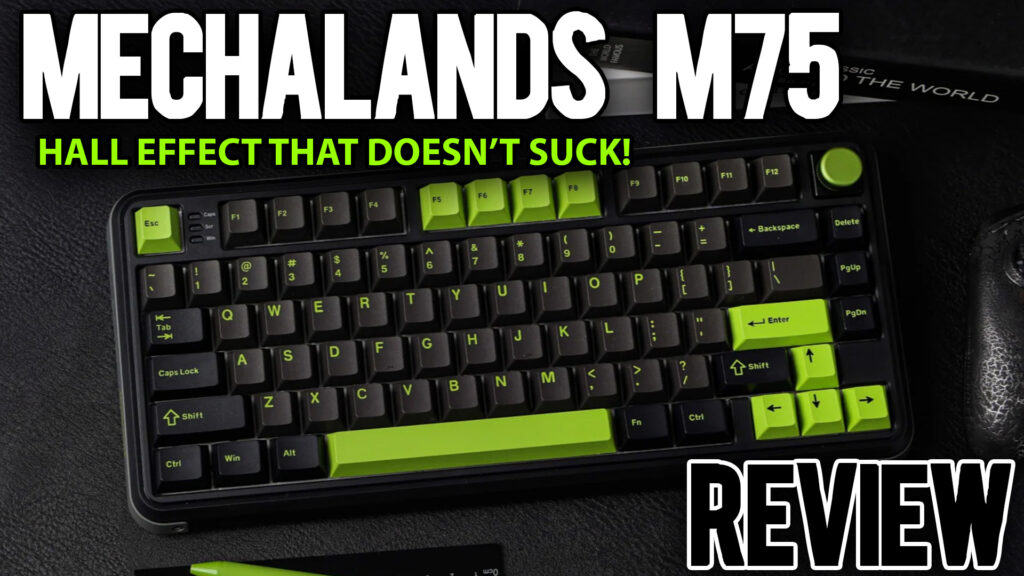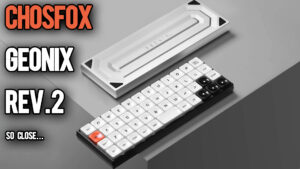💻 Mechlands M75 Review – A Budget Hall Effect Keyboard That Punches Above Its Weight

⌨️ Mechlands M75: https://www.mechlands.com/products/mechlands-m75?sca_ref=8040342.kTcOD8IT6F
⌨️ Amazon Mechlands: https://amzn.to/3G9lJmW
🎥 Watch More Keyboard Reviews: https://www.youtube.com/playlist?list=PLEzayd3M04GAYPRqiCZXNpblVWo5Bsy4r
🏰 Join the community for more tech & keyboard content! https://discord.gg/craftingworlds
If you’re even remotely into the mechanical keyboard scene, you’ve probably heard of Hall Effect switches. They’re fast, analog, and customizable—but also expensive. Most people associate Hall Effect tech with premium-tier boards like the Wooting 80HE, and with good reason. But what if I told you that you could get a genuinely impressive Hall Effect experience for under $70?
Enter the Mechlands M75, a wired, 75% Hall Effect keyboard that might just be the best entry point into the world of analog mechanical keyboards. While it’s not perfect (spoiler: the software is a mess), it packs so much value into such a small price tag that it deserves a serious look—even from seasoned enthusiasts.
⚙️ What’s in the Box?
Unboxing the M75, you’re greeted with:
- A full keyboard with Hall Effect switches pre-installed
- A swappable 4-pin rotary knob (removable and customizable)
- Extra switches and one extra knob cap
- A braided USB-C cable (bonus points for durability)
- Keycap and switch pullers
- Pre-installed PBT keycaps in a green/gray theme reminiscent of the Blade75
Simple, clean, and surprisingly premium feeling.
🧠 Hall Effect Without the Premium Price Tag?
This board runs Otmo Magnetic Switches, a variant of Hall Effect switches that allow analog input, rapid trigger, and customizable actuation points. And here’s the shocker—it actually sounds and feels good out of the box.
The switches have a nice poppy return, almost tactile in feel, despite being linear by design. They’re fast, smooth, and responsive. For typing and gaming, it’s hard to believe this isn’t a modded board. The stabilizers, while not lubed to perfection, hold their own and don’t rattle excessively.
🔧 Build Quality & Design
Visually, the M75 has a fun, slightly retro design. The green accents and black border give off Nintendo Game Boy vibes. It’s a 75% layout, meaning you get your function row and arrows but in a more compact footprint.
Here are some highlights:
- ✅ South-Facing RGB: Vibrant and customizable, including per-key lighting and even a side LED strip.
- ✅ Knob Control: The 4-pin swappable knob can be reassigned via software (in theory—more on that soon).
- ✅ On/Off Switch: Surprisingly rare on keyboards, it’s there if you want it.
- ✅ Mac/Windows Toggle: A physical switch lets you change modes.
- ✅ Adjustable Feet: Two height options—but they don’t lock well and will fold under pressure.
The keyboard is plastic, but doesn’t feel cheap. It’s light, travel-friendly, and the chassis has minimal flex.
📉 Let’s Talk Software (Because We Have To)
Here’s the Achilles’ heel of the M75: the software.
Technically, everything works. You can remap keys, assign macros, create lighting profiles, and adjust Hall Effect settings like actuation distance and rapid trigger.
But the interface is dated, slow, and incredibly unintuitive. Most features require multiple clicks to access. Simulating actuation takes several seconds of loading. Changing RGB settings can lag or crash. And worst of all, there’s minimal tooltips or guidance for new users.
If you’re new to Hall Effect keyboards, this is a steep learning curve. For enthusiasts, it’s a frustrating downgrade from apps like Wootility, VIA, or even Keychron’s newer software.
🧠 Pro Tip: Mechlands/AJazz seems to share this app across several models, including Epomaker boards. So if you’ve used those, it’ll feel familiar—but no less clunky.
🎨 RGB Lighting and Display
Here’s where things turn around. The RGB implementation is shockingly good. Bright, vivid, and responsive. You get per-key lighting, a dedicated light bar on the side, and a small screen that can show battery status, time, and even custom pixel art animations.
The community lighting sharing system is a brilliant touch. You can download user-made animations, like Gengar hopping across your screen. It’s fun, whimsical, and a reminder that keyboards should also bring a bit of joy to your setup.
🔈 Sound Test & Feel
Out of the box, this board surprised me. The Otmo switches sound clean, with a subtle thock that’s far more refined than most sub-$100 boards. They’re not muted like silent switches, but also not sharp or plasticky. It lands in the just right zone.
Stabs are decent. Spacebar was a little uneven—left side slightly hollower than the right—but nothing egregious. There’s a solid balance between bounce and stability, making it great for both fast gaming inputs and long-form typing.
🧪 Downsides and Weird Quirks
Not all is perfect:
- ❌ Software is slow, outdated, and hard to use.
- ❌ Switch removal is difficult—the plastic design around the 4-pin sockets makes pulling switches risky without damaging them.
- ❌ Only one colorway is available, so if you’re not into green, tough luck.
- ❌ No wireless – strictly wired, which may be a turn-off for some.
💸 Value and Who It’s For
At $69 MSRP (even cheaper with coupons), this is one of the cheapest Hall Effect keyboards on the market. And honestly, it delivers 90% of the experience for a fraction of the price.
If you’re curious about Hall Effect tech but aren’t ready to spend $200+ on a Wooting or Keychron Q3 HE, this is a great first step. It’s also an excellent second board for travel, office, or testing switches.
🏁 Final Verdict
“Not perfect, but perfectly priced.”
The Mechlands M75 is the budget Hall Effect keyboard we didn’t know we needed. It’s fun, fast, colorful, and sounds far better than it has any right to. The software needs a total overhaul, and there are a few build quirks, but for the price? This thing is punching way above its weight class.
⭐ Final Rating: 8/10
Buy it if you want to explore Hall Effect switches without emptying your wallet.
Skip it if you rely heavily on software customization or need wireless.
What do you think?
Do you use a Hall Effect board? Is the Mechlands M75 good enough to tempt you? Let me know in the comments—or better yet, join our Discord and geek out with us in real-time: https://discord.gg/craftingworlds



